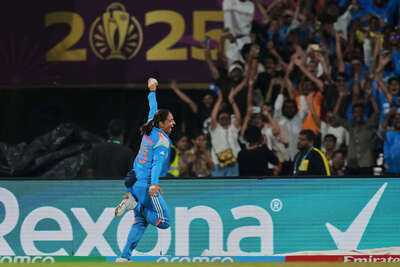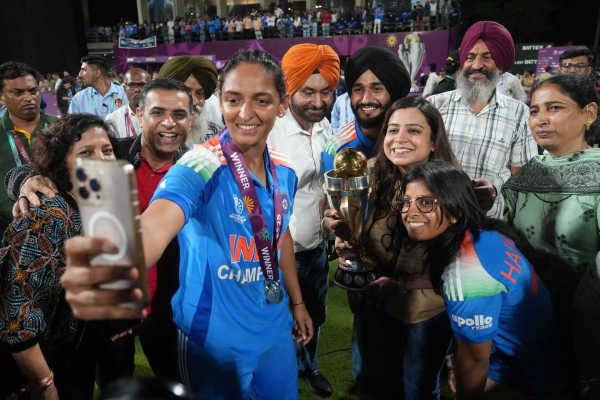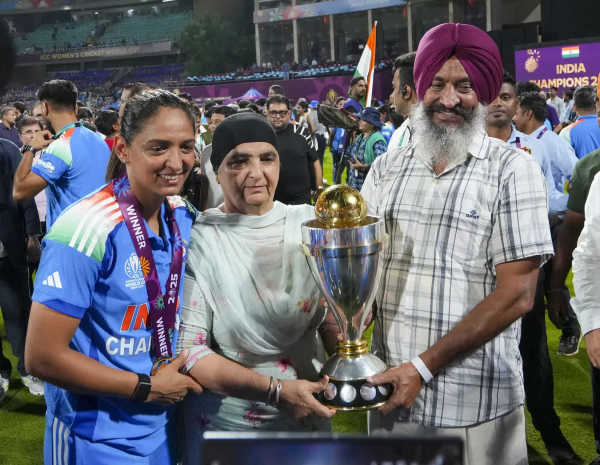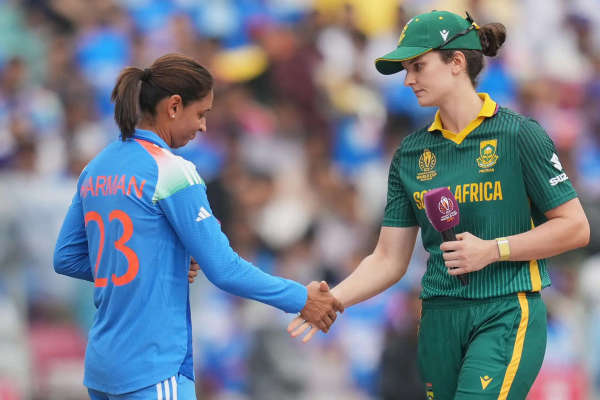
Harry di, India's North Star! Harmanpreet Kaur's 2017 World Cup knock showed that India's talent was global
The Times Of India
newspoint|03-11-2025
The roar inside the DY Patil Stadium in Navi Mumbai was not just a sound; it was a physical weight, a 30,000-strong collective breath of hopes and expectations. This was the 2025 ICC Women’s World Cup semifinal, India vs Australia, and the Indian team was struggling at 59/2, chasing a record 339 to beat the seven-time world champions.
The scoreboard was a knot of tension. In walked Indian captain Harmanpreet Kaur . A gait that demonstrated quiet confidence — shoulders back, bat tucked under her arm like a cavalry sword. She was a blend of aggression and calm authority. She took her guard, the bat tracing a clean arc through the air, settling into a familiar, slightly open stance.
The “fearless brand of cricket” she had meticulously mentioned in her press conferences, thereafter, was on full display at the most crucial juncture of India’s home campaign. Harmanpreet delivered a stirring 89 (off 88 balls), battling cramps and pressure, paving the way for India’s momentous win.
The league stage saw India lose three consecutive matches, which had the critics sharpen their knives. The transformation, thereafter, was seismic. Against the odds, the team rallied, finding a gear no one thought they had. It was Harmanpreet’s leadership — her motivational presence, her ability to make the difficult look inevitable. It transformed the campaign from a nervous breakdown into an inspiring comeback.

To understand the 2025 captain, one must rewind to the moment of genesis: the 2017 ODI World Cup semifinal in Derby, England. If anyone in India has moved the needle for women’s cricket, it was on that rain-interrupted day, July 20, 2017, when Harmanpreet produced an epochal, unbeaten 171 runs off 115 balls to crush the defending champions Australia.
It was the ‘Kapil Dev 175* moment’ for Indian women’s cricket. An innings of unbelievable power and precision, studded with 20 boundaries and seven colossal sixes. It was, and perhaps still is, the single greatest performance by an Indian woman cricketer on the global stage. And the win wasn’t just a win, it was a societal shift.
Cricket suddenly became a two-gender sport in the eyes of millions of new Indian fans. Her ferocity in that knock was a statement, a declaration that Indian women were not just playing the game; they were here to own it, to dominate it and to destroy opponents with unapologetic aggression.

That 2017 knock was the foundation upon which the current era is built. It paved the way for visibility, central contracts, endorsements and a crucial step towards pay-parity with the men. Harmanpreet became the face of this revolution.
Harmanpreet’s journey began far from the bright lights of Mumbai, in the small town of Moga, Punjab. From the day she was born on International Women’s Day, her father, Harmandar Singh Bhullar — a former volleyball and basketball player — celebrated with a T-shirt for her daughter that read ‘Good Batting’.
As a teenager, she would accompany her father to the Guru Nanak College Stadium ground in Moga, playing cricket with boys, clearing boundaries with ease. Her raw power and hunger caught the eye of local coach Kamaldeesh Singh Sodhi , who, along with his son Yadwinder Singh Sodhi , approached her father: “Aap apni beti hume de do” (Give us your daughter). Her father, hesitant at first, eventually agreed, setting the stage for a meteoric rise.

“She was hitting the ball so hard, even as a small girl, that the other kids would complain. They always thought she was aiming for the fence, but she was aiming for the trees beyond the fence. That power was always there,” Harmanpreet’s father had said in an earlier interview.
It was her first coach, Yadwinder Singh Sodhi, who honed that raw power into cricketing technique. Sodhi, who ran a cricket academy at the Gyan Jyoti Public School in nearby Tarapur village, saw a prodigy who wanted no concessions. “She never wanted to bat with soft balls or easier nets. She wanted to face the fast bowlers, the best boys in the academy. Her hitting was natural, but her commitment to practicing the hardest shots — the sixes — was unique. She was ready to take on the world, even when she was just a teenager in Moga,” Sodhi said.
After the 171-run knock, Harmanpreet’s stock rose dramatically, transforming her from a national talent to an international pioneer. She etched her name in history in 2016 by becoming the first India cricketer — male or female — to sign a Big Bash League (BBL) contract with the Sydney Thunder in Australia. The move was monumental. It showed that Indian women’s talent was globally competitive and highly sought after. Her success in the BBL, where she was named Sydney Thunder’s Player of the Tournament, opened the floodgates for other Indian players to pursue overseas T20 opportunities.

Further cementing her status as a pioneer, she was signed to play for the Surrey Stars in the 2017 season of the Kia Super League (KSL), becoming the first Indian woman cricketer to be selected for the team. While she missed that 2017 season due to injury, her KSL journey continued, playing for the Lancashire Thunder in the 2018 and 2019 seasons.
Harmanpreet has also featured in The Hundred for teams like the Manchester Originals and Trent Rockets, leaving a strong mark with her all-round skills. She began with the Manchester Originals in the inaugural 2021 season and has turned out for Trent Rockets from 2023 onwards.
To the younger generation — the Jemimahs, the Shafalis, the Pratikas — Harmanpreet stands as both mirror and window. Mirror of what grit from a small town can achieve; window into the possibilities that come with playing the sport at the highest level in India. The ‘ Harry di ’ who emerged from Moga, who defied conventions to become a six-hitting machine, now stands as a beacon for Indian women’s cricket.
The scoreboard was a knot of tension. In walked Indian captain Harmanpreet Kaur . A gait that demonstrated quiet confidence — shoulders back, bat tucked under her arm like a cavalry sword. She was a blend of aggression and calm authority. She took her guard, the bat tracing a clean arc through the air, settling into a familiar, slightly open stance.
The “fearless brand of cricket” she had meticulously mentioned in her press conferences, thereafter, was on full display at the most crucial juncture of India’s home campaign. Harmanpreet delivered a stirring 89 (off 88 balls), battling cramps and pressure, paving the way for India’s momentous win.
The league stage saw India lose three consecutive matches, which had the critics sharpen their knives. The transformation, thereafter, was seismic. Against the odds, the team rallied, finding a gear no one thought they had. It was Harmanpreet’s leadership — her motivational presence, her ability to make the difficult look inevitable. It transformed the campaign from a nervous breakdown into an inspiring comeback.

To understand the 2025 captain, one must rewind to the moment of genesis: the 2017 ODI World Cup semifinal in Derby, England. If anyone in India has moved the needle for women’s cricket, it was on that rain-interrupted day, July 20, 2017, when Harmanpreet produced an epochal, unbeaten 171 runs off 115 balls to crush the defending champions Australia.
It was the ‘Kapil Dev 175* moment’ for Indian women’s cricket. An innings of unbelievable power and precision, studded with 20 boundaries and seven colossal sixes. It was, and perhaps still is, the single greatest performance by an Indian woman cricketer on the global stage. And the win wasn’t just a win, it was a societal shift.
Cricket suddenly became a two-gender sport in the eyes of millions of new Indian fans. Her ferocity in that knock was a statement, a declaration that Indian women were not just playing the game; they were here to own it, to dominate it and to destroy opponents with unapologetic aggression.

That 2017 knock was the foundation upon which the current era is built. It paved the way for visibility, central contracts, endorsements and a crucial step towards pay-parity with the men. Harmanpreet became the face of this revolution.
Harmanpreet’s journey began far from the bright lights of Mumbai, in the small town of Moga, Punjab. From the day she was born on International Women’s Day, her father, Harmandar Singh Bhullar — a former volleyball and basketball player — celebrated with a T-shirt for her daughter that read ‘Good Batting’.
As a teenager, she would accompany her father to the Guru Nanak College Stadium ground in Moga, playing cricket with boys, clearing boundaries with ease. Her raw power and hunger caught the eye of local coach Kamaldeesh Singh Sodhi , who, along with his son Yadwinder Singh Sodhi , approached her father: “Aap apni beti hume de do” (Give us your daughter). Her father, hesitant at first, eventually agreed, setting the stage for a meteoric rise.

“She was hitting the ball so hard, even as a small girl, that the other kids would complain. They always thought she was aiming for the fence, but she was aiming for the trees beyond the fence. That power was always there,” Harmanpreet’s father had said in an earlier interview.
It was her first coach, Yadwinder Singh Sodhi, who honed that raw power into cricketing technique. Sodhi, who ran a cricket academy at the Gyan Jyoti Public School in nearby Tarapur village, saw a prodigy who wanted no concessions. “She never wanted to bat with soft balls or easier nets. She wanted to face the fast bowlers, the best boys in the academy. Her hitting was natural, but her commitment to practicing the hardest shots — the sixes — was unique. She was ready to take on the world, even when she was just a teenager in Moga,” Sodhi said.
After the 171-run knock, Harmanpreet’s stock rose dramatically, transforming her from a national talent to an international pioneer. She etched her name in history in 2016 by becoming the first India cricketer — male or female — to sign a Big Bash League (BBL) contract with the Sydney Thunder in Australia. The move was monumental. It showed that Indian women’s talent was globally competitive and highly sought after. Her success in the BBL, where she was named Sydney Thunder’s Player of the Tournament, opened the floodgates for other Indian players to pursue overseas T20 opportunities.

Further cementing her status as a pioneer, she was signed to play for the Surrey Stars in the 2017 season of the Kia Super League (KSL), becoming the first Indian woman cricketer to be selected for the team. While she missed that 2017 season due to injury, her KSL journey continued, playing for the Lancashire Thunder in the 2018 and 2019 seasons.
Harmanpreet has also featured in The Hundred for teams like the Manchester Originals and Trent Rockets, leaving a strong mark with her all-round skills. She began with the Manchester Originals in the inaugural 2021 season and has turned out for Trent Rockets from 2023 onwards.
To the younger generation — the Jemimahs, the Shafalis, the Pratikas — Harmanpreet stands as both mirror and window. Mirror of what grit from a small town can achieve; window into the possibilities that come with playing the sport at the highest level in India. The ‘ Harry di ’ who emerged from Moga, who defied conventions to become a six-hitting machine, now stands as a beacon for Indian women’s cricket.
Latest Newsmore

Head Released From T20I Squad To Play Shield Games For Ashes Preparations
03-Nov-2025 • CricketnMore

[Watch] Women's World Cup 2025: Harmanpreet Kaur tries to touch Jay Shah's feet, ICC chairman's gesture wins hearts
03-Nov-2025 • CricTracker

'Unfinished Task From 2017 Has Finally Been Completed,' Says Richa's Childhood Coach Gopal Saha
03-Nov-2025 • CricketnMore

Shastri And Gill Congratulate Team India For Women's World Cup Triumph
03-Nov-2025 • CricketnMore

'Trophy Was Won In The Final, But The Hearts In Semifinal'
03-Nov-2025 • CricketnMore





